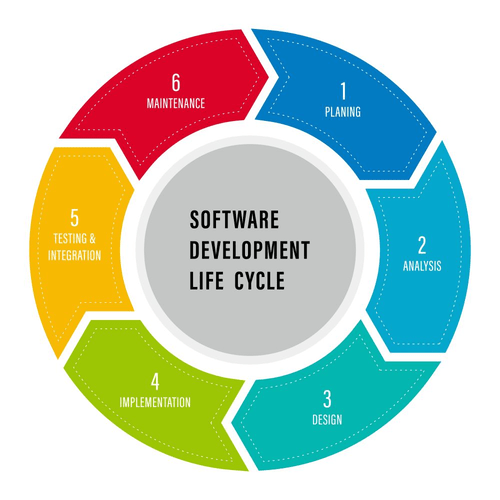Software development
What Are Dora Devops Research And Assessments Metrics?
Содержание
- What Are The 4 Key Metrics In Devops?
- Why I Like Dora Metrics
- # Gitops Days
- Connect Your Team Across Space And Time
- Github Integration For Grafana Cloud
- How Cloudhealth Uses Pluralsight Flow To Debug The Development Process
- # Gitops Days Emea 2020 Youtube Playlist
- Discover More About Pluralsight Flow
GitHub webhook configurationHere I have selected content-type as JSON so that we can easily parse incoming payloads. A quick reminder, don’t forget to place at least a secret authentication for your webhook POST for basic security. You may take a look at the GitHub webhook official guide for this type of security issue. A new commit is pushed to the GitHub repository for a new change request.
- GitOps provides 1) Immutable infrastructure, 2) Single source of truth, and 3) Dev velocity to help you automate security.
- Flow efficiency measures the ratio of active time to total flow time to identify waste in the value stream.
- Deployment frequency indicates how often an organization successfully deploys code to production or releases software to end users.
- Thousands of companies & open-source projects are already trusting GitBook with their docs.
DORA metrics are a framework of performance metrics that help DevOps teams understand how effectively they develop, deliver and maintain software. They identify elite, high, medium and low performing teams and provide a baseline to help organizations continuously DoRa Metrics software DevOps improve their DevOps performance and achieve better business outcomes. DORA metrics were defined by Google Cloud’s DevOps Research and Assessments team based on six years of research into the DevOps practices of 31,000 engineering professionals.
What Are The 4 Key Metrics In Devops?
As Taylor says, “Let’s both dig into that.” Work together to hear each other’s constraints and find where you have shared priorities and benefits that you want for the organization. That way, your peers and stakeholders will realize that you weren’t trying to hurt them or force them into an uncomfortable place. With synchronization, delivery isn’t the last step in the CI pipeline. You can use container registries, ServiceNow and other enterprise configuration management systems.
Code Stays Behind Firewall with Copilot Alternative Tabnine – thenewstack.io
Code Stays Behind Firewall with Copilot Alternative Tabnine.
Posted: Wed, 29 Jun 2022 07:00:00 GMT [source]
Deployment frequency indicates how often an organization successfully deploys code to production or releases software to end users. It’s important to measure the team’s performance, not compare different teams’ performance. The reason we measure DevOps metrics, is always to improve the team performance trends. Anytime we start measuring something, it instantly creates incentives – some positive, some negative.
While traditional performance metrics focus on specific processes and tasks, flow metrics measure the end-to-end flow of business and its results. This helps organizations see where obstructions exist in the value stream that are preventing desired outcomes. The time to restore service metric, sometimes called mean time to recover or mean time to repair , measures how quickly a team can restore service when a failure impacts customers. A failure can be anything from a bug in production to an unplanned outage. An organization’s particular cultural processes — such as separate test teams or shared test environments — can impact lead time and slow a team’s performance. Every time the team finishes a feature (or a user story/task), it’s good to look at it objectively and drill down into details to understand what really happened.
Why I Like Dora Metrics
Mean time to recover is about measuring the time to recover from an outage. Immediately we can see that MTTR is a tricky metric, in that there is so much variation between the definition of an outage. Did my data center fall into the ocean, or is it just a degraded SQL index? Adding to this, is the nearly infinitely combinations of technologies, architectures, and clouds used across every project.
We have used a simple and valid calculation approach for this metric which is provided by Devon Bleibtrey on this blog. All we need to do is just enforce PR titles in your workflows so that you don’t miss any development process for metric calculations. For enforcing PR titles you may use an existing workflow library and I have used enforce-label-action. By measuring the velocity of development and stability of deployment and the product itself, teams are motivated to improve their results during subsequent iterations. Improved processes and fast, stable delivery ﹣that’s what you get after starting to measure your team’s performance with DORA metrics.
The easiest place to start, however, is with Google’s Four Keys open source project, which it created to help DevOps teams generate DORA metrics. Four Keys is an ETL pipeline that ingests data from Github or a Gitlab repository through Google Cloud services and into Google DataStudio. The data is then aggregated and compiled into a dashboard with data visualizations of the four key DORA metrics, which DevOps teams can use to track their progress over time. A DORA survey is a simple way to collect information around the four DORA metrics and measure the current state of an organization’s software delivery performance. Google Cloud’s DevOps Research and Assessments team offers an official survey called the DORA DevOps Quick Check. You simply answer five multiple-choice questions and your results are compared to other organizations, providing a top-level view of which DevOps capabilities your organization should focus on to improve.
See also the new GitOps Working Group in the CNCF, which has been building out the Principles and other GitOps starting points. Flips in Production are triggered manually after some QA the dark production cluster. A possible automated way to calculate the MTTR is to look at the deployment https://globalcloudteam.com/ history and use the time from a fix deployment to the previous failed deployment. This will still miss some outages, but it will require no additional bureaucracy. On promotion, no new binaries/containers are created, hence no build or test is required, only the deployment is needed.

My take is that development is a design and implementation task and varies greatly – it’s why estimates are so often wrong. Have you ever heard an estimate for “10 minutes”, and then watch the task take hours and hours, if not days? I initially started measuring this metric from the first commit in a branch. Note that the goal isn’t always to release to the end user – it you have feature flags the feature might be not enabled, but deployed and ready. DORA metrics can help by providing an objective way to measure and optimize software delivery performance and validate business value. GitHub Apps is a service that helps you automate key processes in your workflow.
# Gitops Days
When considering a metric tracker, it’s important to make sure it integrates with key software delivery systems including CI/CD, issue tracking and monitoring tools. It should also display metrics clearly in easily digestible formats so teams can quickly extract insights, identify trends and draw conclusions from the data. Mean lead time for changes measures the average time between committing code and releasing that code into production. Measuring lead time is important because the shorter the lead time, the more quickly the team can receive feedback and release software improvements. Lead time is calculated by measuring how long it takes to complete each project from start to finish and averaging those times.

It’s a sign of a sound deployment process and delivering high-quality software. A high Change Failure Rate indicates problems in the development process or lack of testing before deployment. Then, when there’s an incident, a team can fix it in a timely manner, so the availability of software isn’t compromised.
In the following sections, we’ll look at the four specific DORA metrics, how software engineers can apply them to assess their performance and the benefits and challenges of implementing them. At Swarmia, we’ve been building our developer productivity and developer experience solution together with some of the best software organizations in the world, including Outreach, Wolt, and Blinkist. I’ve written a lengthier post about measuring software development productivity, but here are a few practical examples for replacing Git analytics. Given that software engineers are expected to commit code, commits per day per developer might seem like a tempting thing to measure.
Connect Your Team Across Space And Time
Learn how each of the metrics works and set the path to boosting your team’s performance and business results. Flow metrics help organizations see what flows across their entire software delivery process from both a customer and business perspective, regardless of what software delivery methodologies it uses. This provides a clearer view of how their software delivery impacts business results.
A post on implementing the DORA metrics, with some discussion of suggested improvements based on difficulty with measurement at scale. Flow efficiency measures the ratio of active time to total flow time to identify waste in the value stream. MTTR begins the moment a failure is detected and ends when service is restored for end users — encompassing diagnostic time, repair time, testing and all other activities. Organizations vary in how they define a successful deployment, and deployment frequency can even differ across teams within a single organization. In the past, he scaled the product development team to 100+ people as the Chief Product Officer at Smartly.io, and founded Flowdock. Ultimately, the most important role of product development is to move the needle of some pre-defined business outcomes.
Build semi-private docs spaces to shares with your clients / users through JWT tokens. In the screenshot above, hovering over the link allows the user to see a high-priority pull request implementing a fix, so they can understand which steps have already been taken to resolve the problem. If anyone wants to do additional research, they can use these link previews to decide which items they want to look at in more depth and quickly pivot to GitHub for more details.
Github Integration For Grafana Cloud
Azure DevOps metric insightsAn interesting insight right away, is that in the ‘things we don’t watch’ section, we can see metrics that shouldn’t be measured at a management level. For example, metrics like team capacity and team velocity are ok within a team – but not when comparing two teams. Comparing team velocity between two teams could encourage teams to start inflating story points. Forget about obscure Git metrics and start improving your software engineering productivity with healthy metrics and the right tools. Impact is one of the most important things for software development organizations to measure, but it can’t be measured with Git analytics.

When Time to Restore Service is too high, it may be revealing an inefficient process, lack of people, or an inadequate team structure. When it’s low, it shows that a team responds and solves problems quickly. Low Time to Restore Service ensures availability and correct functioning of the software. Smaller and more frequent deployments are the target, but the most effective number of deployments will differ from product to product. Delivering code quickly to production comes from shipping as many times as possible while changing the batch size to be as small as possible.
How Cloudhealth Uses Pluralsight Flow To Debug The Development Process
Deploying to production – with changes – requires robust automated testing to ensure we can deploy our changes with confidence. Enabling both the aforementioned source code and GitHub integration takes this functionality even further with inline code snippets. Datadog’s source code integration connects your telemetry to your Git repositories, whether they’re hosted in GitHub, GitLab, or Bitbucket. Once you’ve enabled the integration, you can debug stack traces, slow profiles, and other issues by quickly accessing the relevant lines of code in your repository. By measuring and tracking DORA metrics and trends, teams can make better, more informed decisions about what can be improved, and understand how to do that.
GitOps allows for app teams to act more autonomously, or otherwise put, it enables a self-service model. App team independence contributes to both decreasing lead time and increasing deployment frequency. ECS lambda Cloudwatch logsTill now, we have completed all necessary steps for the “Change Lead Time” metric calculation. But we can easily calculate “Change Failure Rate” with existing events which were GitHub Pull Request events. Actually we have collected Pull Request events specifically for this purpose and it will be so easy for us to calculate “Change Failure Rate” metrics for development processes.
In contrast, each of the four DORA metrics encapsulate multiple metrics – essentially creating a three-dimensional view. Two years ago, I started a hack to understand DORA metrics on a deeper level, creating a DevOps Metrics project on GitHub. The original plan was to build a tool that could capture and analyze data from GitHub and Azure DevOps – my two primary DevOps tools at the time.
